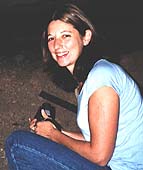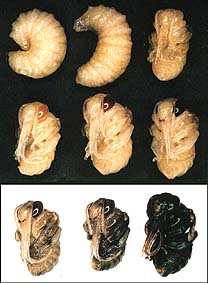Home
Aussie Bee Online
Welcome
New Articles
About Native Bees
Bee Photo Gallery
Bees in Your Area
Common Questions
Rescuing Native Bees
Exotic Bumblebees
What are Stingless Bees?
Buying Stingless Bees
Honey Production
Crop Pollination
Study Native Bees
Field Guide
Information Booklets
Tim Heard's Book
John Klumpp's Book
Aussie Bee Back Issues
Seminars
Links
Support Native Bees
Aussie Bee Shop
Order Form
Who We Are
Donations
Privacy Policy
Free Newsletter
Website Survey
Download Printer-Friendly PDF version of this article
Blue Banded Bees:
Potential Pollinators of Glasshouse Tomatoes
Dr Anne Dollin
Australian Native Bee Research Centre
November 2001
Melissa Bell of the University of Western Sydney – Hawkesbury is conducting Australia’s first-ever glasshouse experiments with blue banded bees. These trials, in collaboration with the Australian Native Bee Research Centre, are testing the potential of Australian native blue banded bees (Amegilla) as pollinators of glasshouse tomatoes.
 |
Tomato crops grown inside glasshouses need a special kind of pollination to maximise their production. The flowers must be vibrated to release the pollen which is held inside tiny capsules in the flower. In Australia this process is currently done manually with mechanical vibrators. However, in overseas countries European bumble bees (Bombus) are often used to do this job.
Australia has no native species of bumble bees, and horticulturalists are applying to introduce European bumble bees to mainland Australia for crop pollination. Conservationists, however, are most concerned about the impact such an introduction would have on our Australian environment (see Aussie Bee Bulletin Issue 13). Could an Australian native bee be used instead to pollinate glasshouse tomatoes? Melissa Bell’s experiments are showing that this may indeed be possible.
Early Success in the Glasshouse
The earliest stages of this pioneering experiment were described in Issue 17 of Aussie Bee Bulletin. Blue banded bees were successfully introduced into a University glasshouse room (5.25 m long x 3 m wide x 4.3 m high) in late March, 2001. The bees rapidly accepted the confined space and began feeding on flowers and honey feeders that we had provided.
Les Dollin of the Australian Native Bee Research Centre made 55 nest blocks for the bees. These were Besser bricks, each filled with a soft clay mixture. Soon the bees began visiting these blocks too, digging nesting holes and bringing in supplies of pollen.
Blue Banded Bees Don’t Fly During Winter
In April and May, at the natural nest sites (outside of the glasshouse) all the adult bees die as the cold weather starts. In the nest burrows, though, immature bees (called prepupae) are curled up inside their sealed cells. These prepupae become dormant during winter and stay inside their cells until the weather warms up in spring. Then they complete their development into adults and emerge into the sunshine to begin the new flying season. So from about May to October no adult blue banded bees can be found flying in the garden.
So How Can We Pollinate Crops in Winter?
The biggest challenge with pollinating glasshouse tomato crops is that they flower all year round. If we want to use blue banded bees to pollinate these crops we will need to be able to supply flying adult bees during the cold months when the bees are normally dormant. Melissa wondered if she could make some of the blue banded bee prepupae develop into adults much earlier than usual by keeping them at warmer temperatures.
 |
Thus Started a Huge Experiment
Melissa made up many little plastic dishes holding small batches of blue banded bee prepupae. She stored these dishes in incubators set at various temperatures from 8 up to 29 degrees C. Patiently Melissa watched her little charges, day be day, carefully adjusting the temperature and humidity to keep them healthy. Melissa divided the development process from prepupa to adult into nine different stages (see photographs) and diligently recorded the number of days it took each bee to develop from stage to stage.
 |
Sure enough by mid September many of Melissa’s prepupae developed into adults which she then released into the glasshouse room. We were excited to note that at our main natural nest site (outside of the glasshouse), the bees had not even started to fly by late November. So Melissa’s experiments had been very successful in making the prepupae develop into adults much earlier than they would have done in the wild!
Other Discoveries
At one of the natural nest sites, Melissa also discovered some other insects that had been sharing the nest burrows with the blue banded bees. There were some flies (Miltogramma), some grain moths (Sitotroga) and a black and white spotted Domino Cuckoo Bee (Thyreus lugubris – see Aussie Bee Issue 10). Some insects that are found in nests simply share the burrow with the bees whilst other insects may be harmful parasites. The cuckoo bees, for example, can be harmful because they eat the food stored for the blue banded bee’s young. Melissa also found that many blue banded bee nests in the wild were riddled with fungus. We need to learn much more about these things that endanger the nests of blue banded bees.
The Studies Continue…
Melissa recorded detailed information during her experiment about the development rates of bees at many different temperatures. However, further studies still must be done before we can select the best possible conditions for producing blue banded bees, all year round, for crop pollination. More work also needs to be done to improve the designs of the feeders and nest blocks, and to find ways to protect the bees from parasites. Experiments will also be needed to find out how effectively blue banded bees pollinate tomato flowers, in comparison with the manual pollination methods that tomato growers currently use.
Over the next three years Melissa hopes to pursue her research on blue banded bees as she studies for her PhD at the University of Western Sydney – Hawkesbury. The Australian Native Bee Research Centre looks forward to continuing to collaborate with Melissa and her supervisor, Associate Professor Robert Spooner-Hart in these exciting studies. We hope that this research will enable us to produce a commercially viable stock of native bees for the pollination of glasshouse tomato crops in Australia.
• Download the PDF version of this article.
(If you have not used PDF before, click here.)
• For more interesting Aussie Bee Online articles on native bees, visit the contents
|
Please feel free to print out this article or to email copies of the PDF version to your friends. This article may also be reproduced or hosted on other websites providing it is kept in its full and unaltered form including ANBRC contact details.
|
.Search Aussie Bee Website:
© 1997-2018 Australian Native Bee Research Centre
PO Box 74, North Richmond NSW 2754, Australia